
Editor's note: Last month we showed you how to cure most of the common engine-related issues associated with the 6.0L Navistar International-built V-8. The mill can be found in a variety of diesel-powered Ford platforms, including Super Duty pickups, Econoline vans, and Excursion SUVs. Our coverage was tailored specifically for the heavy-duty pickups built between 2004 and 2007. This time we're going to demonstrate how much power you can expect to make with a series of proven modifications that do not compromise longevity. Installing performance- and durability-enhancing upgrades such as the Banks Big Hoss Bundle featured in this article can be a rewarding and fun endeavor. Naturally, you want to begin such a project with a sound and solid platform. The many recommendations featured in last month's issue coupled with the upgrades detailed here in Part 2 will not only result in a powerful, useful, and incredibly versatile machine, but also one on which you can depend for many years to come.
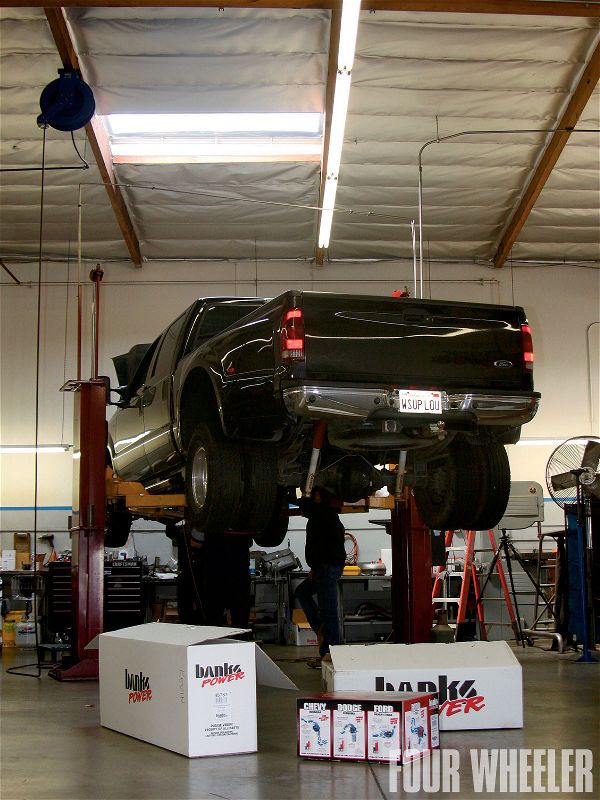
Gale Banks knows diesel engines. Having been in the business for more than 52 years, his name is to the diesel industry what Vic Edelbrock's is to hot rods. And it didn't become that way by accident. Banks is a detail-oriented man, who stops at nothing to ensure that his products are innovative, reliable, and user-friendly. His electronics feature triple redundancy to ensure fail-safe operation, and his no-smoke approach to producing power is as forward thinking as you can get. We have been to his impressive manufacturing facility in Azusa, California, a handful of times and can attest to the high level of detail and thought he so proudly puts into his products. Above all, we felt Banks was the best possible fit for a 6.0L build because his power numbers are expertly metered to be safe and sustainable for an engine that is already pushing the limits of reliability in stock form. For this story, we spent three days at the Banks factory, including several hours with the legend himself. The experience was surreal and the results were impressive. Check it out.
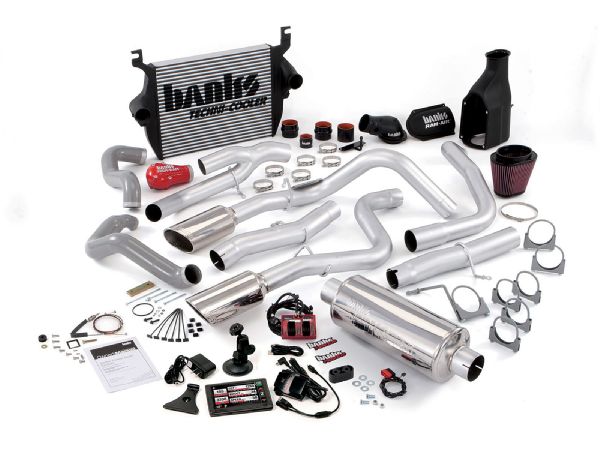 This is the complete Banks Big Hoss Bundle for the Ford 6.0L. The system includes improvements in every aspect of intake, intercooler, and exhaust flow. It even comes with an adjustable power module that adds up to 138 horsepower and 231 lb-ft of torque without any additional smoke. The system includes a driver's interface, the Banks IQ, which is Windows CE-based. Think of it as a little dash-top PC that features a 5-inch touch screen and open platform flexibility. Virtually any Windows CE program you run on your home PC will work on the IQ. The biggest innovation with this setup is the Banks Speed Brake, but we will get into that a little later.
This is the complete Banks Big Hoss Bundle for the Ford 6.0L. The system includes improvements in every aspect of intake, intercooler, and exhaust flow. It even comes with an adjustable power module that adds up to 138 horsepower and 231 lb-ft of torque without any additional smoke. The system includes a driver's interface, the Banks IQ, which is Windows CE-based. Think of it as a little dash-top PC that features a 5-inch touch screen and open platform flexibility. Virtually any Windows CE program you run on your home PC will work on the IQ. The biggest innovation with this setup is the Banks Speed Brake, but we will get into that a little later.
Where 6.0L Power Stroke Inefficiencies Start
To harness additional power from a 6.0L engine, you must first understand where the OE design falls short. Think of an engine as a massive air pump. As fresh air passes through the stock filter, resistance rears its ugly head right from the start. The inlet to the filter housing features a small opening that inhibits airflow to decrease noise and the likelihood of water intrusion. The paper filter element resembles a four-pack of paper towels, like the kind you might find on the shelf at your local supermarket. Only these towels have been squeezed tightly together to increase surface area. While the OE element does a great job removing particulates from the air, it does so at a significant cost to efficiency-especially after several thousand miles of debris becomes trapped in the first few inches of its labyrinth-like design. After the filter, airflow makes an abrupt left turn, creating turbulence and further resistance. The result is a significant amount of suction restriction for the turbo to overcome to do its job. The effect is compounded by a 2-inch-diameter turbo boost discharge tube that has a section that is compressed even further to clear a part of the battery tray. Next, charged air passes through the factory intercooler, which features internal support partitions that interrupt flow. Can you see a pattern? Ultimately, the whole engine intake design is flawed if performance is a factor. The folks at Banks have addressed these issues and figured out a way to open up a window of efficiency for the 6.0L to capitalize on.
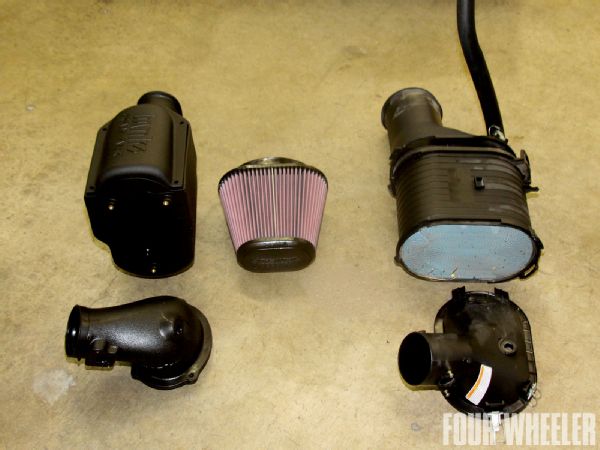 Here you can see the differences between the factory air filter assembly and the improved Banks unit, which uses a cleanable dome-shaped cotton filter element instead of a one-and-done paper element filter. The new arrangement outflows the factory setup by 38 percent.
PhotosView Slideshow
Here you can see the differences between the factory air filter assembly and the improved Banks unit, which uses a cleanable dome-shaped cotton filter element instead of a one-and-done paper element filter. The new arrangement outflows the factory setup by 38 percent.
PhotosView Slideshow
Getting Power to the Ground
The Ford 6.0L engine can be built to deliver outstanding power and torque, and it can do so reliably as long as you address all the major problems first. However, even with all the problems addressed, you will never get the power to the ground without a better torque converter. The factory TorqShift automatic transmission that comes behind all 6.0L pickups includes a torque converter that is rated for 740 lb-ft of torque. Anything above that and you will end up with torque converter slippage. When slippage occurs, the transmission fluid becomes overheated, which reduces fluid life drastically. Ultimately, enough slippage will result in a transmission failure. To protect your transmission, we recommend installing an upgraded torque converter. The Banks converter we installed has a much better design and offers an outstanding 1,100 lb-ft of torque capacity.
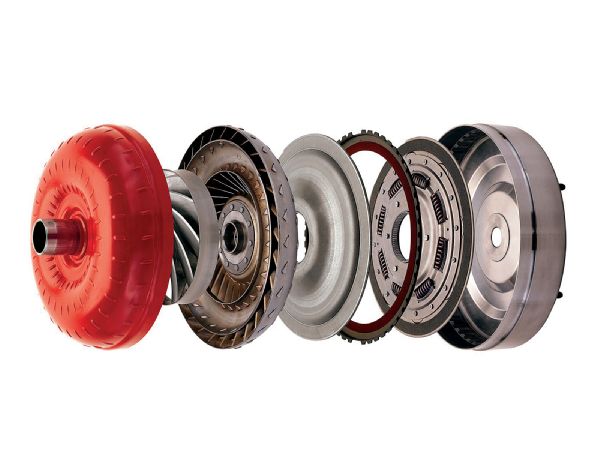 Starting with a one-piece billet housing that is CNC-machined from a steel forging, the Banks torque converter is all business. The turbine and impeller structures are furnace-brazed to help maintain rigidity, and the hardened turbine hub will not deflect like the factory's non-hardened design can. The pump drive is made of 4130 chrome-moly steel, and the whole unit is precision-matched to the torque band of the 6.0L Power Stroke. With this unit installed, the TorqShift automatic transmission handles the additional torque we plan to produce using the Banks Big Hoss system.
Starting with a one-piece billet housing that is CNC-machined from a steel forging, the Banks torque converter is all business. The turbine and impeller structures are furnace-brazed to help maintain rigidity, and the hardened turbine hub will not deflect like the factory's non-hardened design can. The pump drive is made of 4130 chrome-moly steel, and the whole unit is precision-matched to the torque band of the 6.0L Power Stroke. With this unit installed, the TorqShift automatic transmission handles the additional torque we plan to produce using the Banks Big Hoss system.
The Banks IQ
We're not always big proponents of high-tech whizbang gadgetry, but in the case of the new Banks IQ, let's just say we're now active members of the geek committee. This little 3x5-inch computer packs a serious punch, giving you in-vehicle access to virtually any Windows CE-based software available today. In addition, it does things like play music or open up Microsoft Office files for viewing. It doubles as a code scanner, and it can even function as a touch-screen GPS unit. There really isn't much that this device can't do. All extras aside, this unit serves as the primary interface to the Banks Six Gun power-adder. Once installed, the IQ provides you with all the truck's vitals via one of the three pre-programmed gauge screens. This allows you to keep an eye on engine oil temperature, coolant temperature, EGTs, and boost pressure on one easy-to-read screen. The IQ also comes with a new user function that we tested and absolutely love. Banks calls it the SpeedBrake. It works by manipulating the torque converter's lock-up clutch in conjunction with deliberate transmission downshifts. It works similarly to the newer transmissions found in late-model pickup trucks. But Banks took this technology a step further by controlling the variable-geometry turbo vanes. When actuated, the SpeedBrake system delivers seatbelts-required stopping power without even touching the brake pedal. It will literally take an unloaded pickup truck from highway speeds down to 15 mph in under 20 seconds flat on the highest setting. Because the system is totally independent of the actual braking system, it provide those of us who tow a whole new tool for negotiating those steep downhill grades. This is particularly handy when towing a heavy trailer. We did not understand why the factory systems found in newer pickup trucks could not match the performance of the SpeedBrake system, so we asked Banks about it. He told us he holds the patent that allows such a system to control all three systems simultaneously and that nobody else could do it his way without licensing his patent. Did we mention how smart this guy is?
Letting the Heat Out
We covered the intake side of things; now it's time to delve into the exhaust. Keeping with the idea that a diesel engine is simply a large air pump, it is easy to understand why additional intake volume requires a less restrictive exit route. Without such an escape, excessive backpressure can result. Today, exhaust systems are considered emissions control devices by the federal government. This means that any sort of upgrade or revision should have a California Air Resources Board E.O. number to ensure 50-state emissions legality. Banks goes to great lengths to adhere to this policy.
Testing
With all the modifications complete, we began our testing with a trek from Southern California to the San Francisco Bay area pulling a 40-foot Stellar toy hauler loaded with camping supplies, tools, and a Kawasaki Teryx side-by-side. With a trailer weight in excess of 20,000 pounds (a massive load by any measure,) we trudged onward, confident in our Banks Big Hoss Bundle-equipped donor truck's ability to pull the infamous Cuesta Pass grade on Highway 101, just north of San Luis Obispo. Ambient air temperature was right around 85 degrees. We started at the bottom of the hill in Drive with the "tow/haul" mode engaged. The Banks Six-Gun was left in "Tow" mode. About halfway up the hill, we noticed the EGTs were hovering right around 1,100 degrees, indicating that the Banks software was doing its job to maintain acceptable heat levels. Engine oil and coolant temps climbed, which was to be expected and "normal" in light of the truck's loaded condition. Overall speed, acceleration, and power were more than adequate given the weight we were hauling, and greatly improved over a purely stock 6.0L. All things considered, we were very pleased with the performance of the Banks Big Hoss Bundle on our donor's F-350.
With the engine oil temperature at 247 degrees, the Banks IQ was alerting us to a high oil temperature condition. Notice the red "oil" indicator in the right-hand side of the screen (arrow). Evidently, this warning comes on at whatever temperature the end user decides to set it at, but seeing as our unit was brand-new, the factory default of 235 degrees was the established point. At the top of the grade we noticed that the engine oil temperature was 254 degrees-not at all outside of the acceptable range for the fully synthetic Amsoil we installed in last month's issue, but we wanted to double-check it for ourselves. We pulled over at the top of the hill and inspected several places under the hood with our hand-held laser thermometer tool. We found the engine oil temperature was much cooler (198.4 degrees) coming out of the Bulletproof Diesel air-to-oil cooler. We questioned a rep at the Banks tech hotline about where the IQ gets its reading. They politely informed us that the signal comes from the factory engine-oil temp sensor located near the high-pressure oil pump in the valley of the engine. We suspect that the location is probably affected by heat from the combustion chambers and is not a reliable source to judge by.
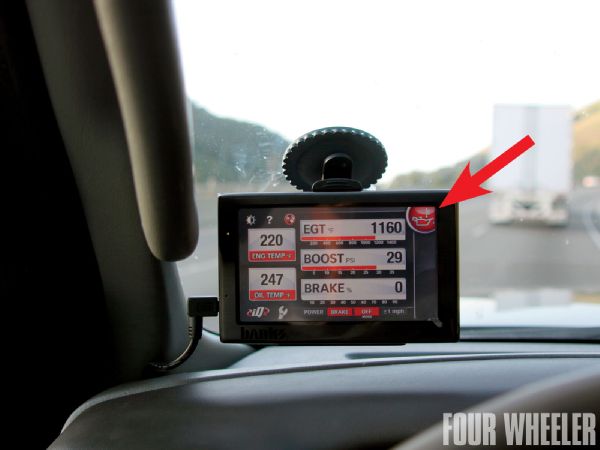
Conclusion
As we went to press, our donor truck had racked up nearly 6,000 miles of hard towing without any problems. We've demonstrated that the 6.0L Power Stroke can be made to run much stronger and without any of the reliability issues that plagued these vehicles from the factory. The peak power generated at the rear wheels by our donor's truck after the project was completed was 380 hp and 690 lb-ft of torque-not to mention a very welcome increase of 2.3 mpg in highway fuel economy.











